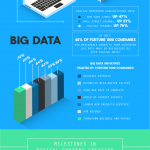3 Innovative Companies With Agile Leadership
— August 23, 2017

We don’t have to look far to find examples of innovation, whether it’s in the technology sector, consumer goods or manufacturing.
Apple, Amazon, Tesla, Southwest Airlines, General Electric, Pfizer, Nike and others make the short list of the most innovative companies year after year. While pioneering a unique product or service is certainly part of the equation, what allows these companies to sustain that success over time really comes down to flexible agile leadership.
Leadership agility is the ability to effectively balance three factors that drive organizational performance – people, processes and innovation.
For a closer look at agile leadership in practice, let’s examine how three of America’s most innovative companies have adapted to a changing marketplace to rise above the competition time after time.
Amazon: Advancing Adaptation and Efficiency Simultaneously
From books and electronics to cloud computing and artificial intelligence, Amazon has its hand in just about everything. Amazon Web Services is a multi-billion dollar provider of cloud-based services, and the company’s Alexa AI assistant service is being built into everything from refrigerators to vehicles.
Amazon’s success is largely a credit to CEO Jeff Bezos’ obsession with customer loyalty, efficiency and adaptation. It could have stuck to its core competency of selling books online, but as e-commerce evolved, Bezos made sure its offerings did, too. The company also made sure that as it made changes, efficiency and customer service would remain a priority. Many companies have made the mistake of focusing so much on technological advances at the expense of keeping their products efficient to produce and use and are cost-effective. Ford Motor Co. is just one example of a company that made this mistake, and it came at a substantial cost. Bezos refused to let Amazon fall into this trap, opting to focus on advancing innovation and efficiency simultaneously. He pushed his team to find new ways to use technology to improve delivery times. As a result, Amazon has invested heavily in its own fleet of drones to be able to deliver products in less than two hours.
Amazon has also announced plans to invest in a fuel-cell manufacturer that will allow the electric vehicles in its warehouses to charge faster, improving delivery efficiency while also meeting sustainability goals.
Amazon has shown it’s possible to balance two seemingly conflicting priorities. The key is to take a systems view of the organization in order to understand how these areas are related and affect each other and put forth a dedicated effort toward each. One way to achieve this is by assigning a different individual or team to take the lead on each effort and hold them accountable for communicating and coordinating their efforts.
Tesla Motors: Making Innovation More Efficient
The automotive industry is constantly evolving, driven by advances in technology and growing consumer expectations. However, it can be difficult for manufacturing giants to implement change quickly because of the complexity of their products.
Fortunately, Tesla owner Elon Musk had the foresight to recognize the trend toward automating the driving experience early on and did something to set the company up to stay ahead of the curve: It installed the hardware to allow for semi-autonomous functionality. Instead of adding new features with each technological advancement, it can simply update its software to roll them out. In 2016, it added autopilot parking, and full self-driving capability isn’t far behind.
In this way, Tesla is able to maintain an efficient manufacturing process that enables them to introduce new features while managing cost. Like Bezos, Musk also recognized the importance of finding ways to advance innovation and efficiency at the same time.
Facebook: Balancing Innovation with Product Reliability
With more than 2 billion users, it would seem Facebook has earned the right to sit back and let the money roll in. In 2016, it generated more than $ 26 billion in revenue, about 80 percent of it from mobile ads. It would never have achieved this profitability if CEO Mark Zuckerberg hadn’t had the vision to monetize the platform while ensuring the user experience continues to be highly reliable and engaging. Maintaining that balance requires constantly introducing new features and testing them relentlessly. It has recently rolled out new mobile ad formats, including 360-degree video, interactive carousel ads and the ability for users to buy tickets to concerts, cruises and more directly from their newsfeeds. They are keeping up with the latest technological advances while also ensuring they don’t jeopardize the customer experience. To keep users engaged, it has introduced new features such as Facebook Live and Stories, which mirrors the user experience of Snapchat.
Innovation is crucial to staying ahead of the competition, but as we’ve seen in the past few decades, it can have a negative impact on a company’s people and processes.
The most successful leaders keep a close eye on the marketplace and invest in innovation while ensuring it doesn’t come at the expense of either employee engagement and motivation or product reliability and process efficiency.
Business & Finance Articles on Business 2 Community
(36)













